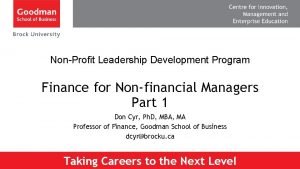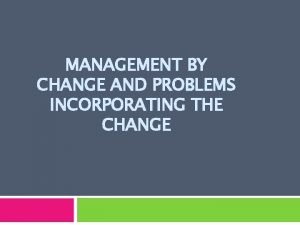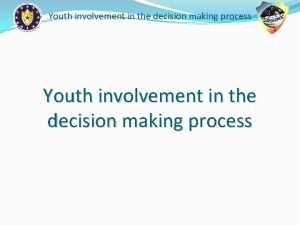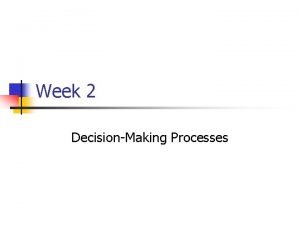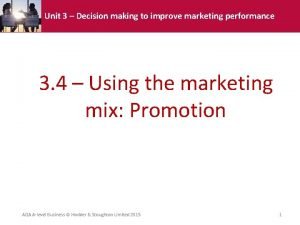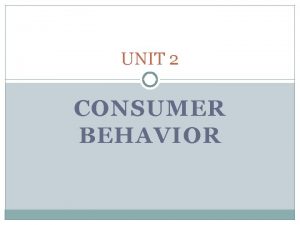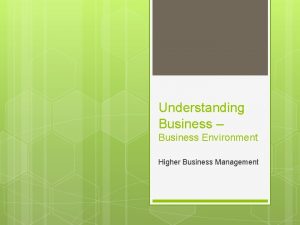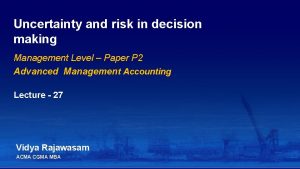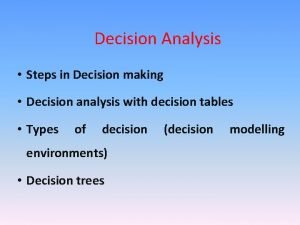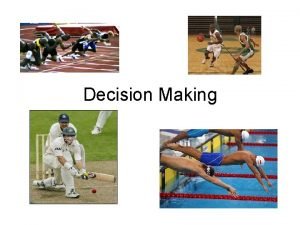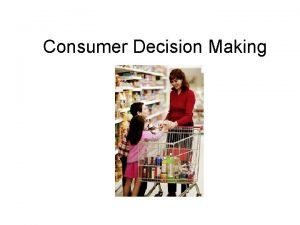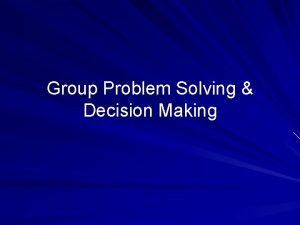Incorporating nonfinancial data into organisational decision making Module
























- Slides: 24

Incorporating non-financial data into organisational decision making Module 3

This material has been developed as part of the UTS Business School and Ernst & Young ‘Leadership & Change for Energy Efficiency in Accounting & Management’ project. The project is supported by the NSW Office of Environment & Heritage as part of the Energy Efficiency Training Program. For more information on the project, please go to: http: //www. business. uts. edu. au/energyefficiency/. This presentation is for educational purposes only, and does not contain specific or general advice. Please seek appropriate advice before making any financial decisions. 2

Agenda ► ► ► Introduction What is non-financial performance? Case Study Measuring non-financial performance Types of non-financial performance Evaluating non-financial performance ► ► 3 Setting KPIs Brand/reputation impacts

Outline 4

Learning Objectives At the end of this module, you will be able to: ► Understand the importance of considering non-financial information in decision making ► Determine key non-financial information required for decision-making ► Measure and evaluate non-financial metrics effectively ► Set effective targets and/or goals ► Understand the key risks and opportunities associated with setting and disclosing targets and commitments 5

Introduction The importance of considering non-financial information in decision making: ► Changing business world; more complex business environment; greater stakeholder expectations; making longer-term (investment) decisions ► Externalities and the free rider principle ► Efficient markets and full costing of products and services > including the full costs (including environmental costs) associated with the production, distribution, use, and disposal of products and services 6

The life cycle costing theorem Raffish, N. 1991, ‘How Much Does That Product Really Cost: Finding Out May Be As Easy As ABC’, Management Accounting, March, pp. 51 -54. 7

What is non-financial performance? ► Companies implementing energy efficiency opportunities are likely to achieve a range of non-energy financial benefits and, where quantifiable, these need to be factored into the energy efficiency opportunity analysis. ► Where such benefits cannot be quantified, they should be noted in the opportunity assessment so that these are visible to decision makers. ► Key indicators of non-financial performance – people, community, environment, customer, supplier 8

Case Study – Company ABC ► Company ABC’s property division is considering replacing a cooling tower at one of its properties. The engineer commissioned to assess the cooling tower found that increased heat recovery will enable the decommissioning of a cooling tower. What are the potential savings (financial and nonfinancial) that you may identify in this project? 9

Case Study – Company ABC (cont. ) The savings are: ► electricity (a 15 k. W fan and a 37 k. W pump, both operating at 90% of installed rating with electricity price of 5 c/k. Wh) ► water (200 m 3/d at a price of $0. 50/m 3) ► chemicals ($7000 pa) ► maintenance ($7000 pa) ► Operating hours 6000 pa, 250 days pa 10

Case Study – Company ABC (cont. ) ► ► Total savings = Energy Savings + Water Savings + Chemical Savings + Maintenance Savings ► = ((Fan [k. W] + Pump [k. W]) x electricity price [$] x operating hours [h]) + (Water flow rate [m 3/d] x Water Price [$/m 3] x operating days [days / pa]) + Chemicals [$] + Maintenance [$] ► = ((15 + 37) x 0. 9 x 0. 05 x 6000) + (200 x 0. 5 x 250) + 7000 = $53, 040 p. a. 11

Measuring non-financial performance ► Numbers without dollars ► Information inputs required in the calculation of key nonfinancial metrics ► ► Energy consumption Fuel consumption ► Seek external experts where needed – e. g. Engineers ► Examples of measuring common non-financial metrics ► ► ► Emissions and energy consumption Employee engagement – impacts on productivity, etc. Using frameworks/standards 12

Full Costs Easy to Measure ► Salvage Value of Surplus Assets ► Avoided or Deferred Capital Expenditure ► Productivity Improvements ► Product quality Improvements ► Greenhouse Gas Emissions Reduction Not-so-easy to Measure ► Security of Supply ► Occupational Health and Safety ► Productivity 13

Salvage Value of Surplus Assets ► An energy efficiency opportunity can lead to assets becoming surplus to requirements. Such assets may have a salvage value that can be realised. This value should be recognised during the financial evaluation of the opportunity. ► Continuing the cooling tower example. The decommissioned cooling tower has a salvage value of $10, 000. There is a $10, 000 credit to the energy efficiency project in the year in which the salvage value is realised in year one. ► ► 14

Avoided or Deferred Capital Expenditure ► Reduced energy consumption may create sufficient spare capacity in a utility or process such that there is no need to install extra capacity for other expanding or new loads. This value needs to be recognised in the evaluation of the opportunity. Example: ► Minimisation of inappropriate air use (by installing a dedicated blower) means a new air compressor is not required to run a new packing line. ► The avoided capital cost for the air compressor of $125, 000 is recognised as a benefit in the air blower project in the year in which the capital expenditure is avoided. 15

Productivity Improvements ► Implemented energy efficiency opportunities may lead to productivity improvements. On sites where energy supply is the capacity constraining factor, reducing energy consumption in one part of the operations can enable a capacity increment elsewhere. Such productivity improvement is likely to be a valuable side effect of the energy efficiency opportunity. ► Conversely, a production rate improvement will often lead to reduced energy intensity. The fixed component of energy use (building services, start up, shutdown) will be spread over a greater volume of product. 16

Product Quality Improvements ► Energy efficiency opportunities may lead to product quality improvements. This could occur where better control of an energy input also reduces variability in a production operation resulting in a more consistent product. Such quality improvement is likely to be a valuable side effect of an energy efficiency opportunity. ► An energy efficiency opportunity may result in a production quality decrease. This should also be foreseeable and detected as a cost in the evaluation process. 17

Greenhouse Gas Emissions Reduction ► Where fossil fuel generated energy is used by a company, reducing the fossil fuel derived energy use will lead to reductions in greenhouse gas emissions. ► The Clean Energy Future Package will place a price on carbon. This will increase the avoided cost attributable to energy efficiency measures. 18

Security of Supply ► ► ► Many businesses are heavily reliant on energy to ensure their business can continue to operate With greater demand for energy services, especially during peak periods, there is a risk that supply may be limited during these times Energy efficiency initiatives reduces this the risk of reliance on external sources of energy, e. g. Electricity Example ► Company ABC installed a tri-generation plant at its data centre. By not having to rely on electricity from the grid, it will continue to operate even during a black-out period How do you factor this reduced risk into your analysis? 19

Occupational Health and Safety ► Energy efficiency opportunities can also lead to improved working conditions and safety for employees. Example ► A new hot water system incorporates a water temperature controller(s) which enable the precise temperature to be set. This eliminates the need to mix hot and cold which provides energy savings and improved safety. How do you factor this reduced risk into your analysis? 20

Evaluating non-financial performance ► Assessing the numbers – what to look for? ► How to compare? – performing analytical procedures ► Benchmarking against peers, industry and leading practice 21

Setting KPIs Goals set that describes Senior Management’s overall aim Targets set to achieve the Goals Requirements: KPIs set to track performance against goal and milestones on the way 2 • • • Specific Measurable Achievable Realistic Time-related • Utilise ‘metrics’ (such as intensity) for consistency between operations

Brand reputation impact ► ► ► Getting it wrong – ‘spin’ over substance Companies historically looked at ‘sustainability’ as a trend, and capitalised on market opportunities Some seen as ‘green-washing’ – hiding facts in ‘spin’ ► ► ► 2 V 8 Supercars – claims of offsetting emissions from planting 10, 000 native trees LG – claimed that four washing machine models had 4 A efficiency ratings but these had not been tested ‘Goody’ plastic bags – claimed to be biodegradable and compostable but this was not the case

Thank you Module 3
 Wharton finance for nonfinancial managers
Wharton finance for nonfinancial managers Objectives of decision making
Objectives of decision making Investment decision financing decision dividend decision
Investment decision financing decision dividend decision Incorporating the change
Incorporating the change Picking up and incorporating dna from dead bacterial cells
Picking up and incorporating dna from dead bacterial cells Nested quotation example
Nested quotation example Incorporating pronunciation
Incorporating pronunciation Incorporating in ohio
Incorporating in ohio Unconventional cash flow
Unconventional cash flow C device module module 1
C device module module 1 Operational data vs decision support data
Operational data vs decision support data Module 9 you make the decision
Module 9 you make the decision Decision tree and decision table
Decision tree and decision table Involvement decision making
Involvement decision making Ethical rules screen nasw code of ethics
Ethical rules screen nasw code of ethics Systematic decision making process
Systematic decision making process Paced decision making
Paced decision making Mamdm
Mamdm Using recursion in models and decision making sheet 3
Using recursion in models and decision making sheet 3 Paced decision making
Paced decision making Unit 4 lesson 1 decision making
Unit 4 lesson 1 decision making How to improve marketing performance
How to improve marketing performance Types of decision making
Types of decision making Internal business management
Internal business management Decision making unit example
Decision making unit example
